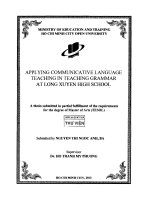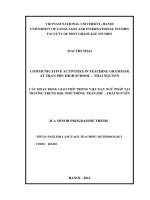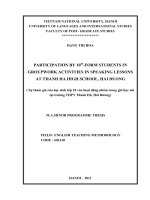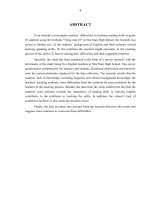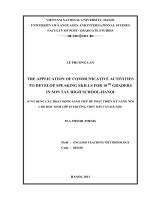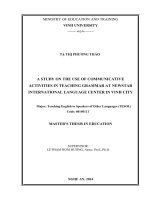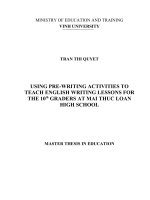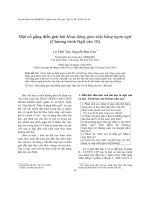Communicative activities in teaching grammar at Tran Phu High School, Thai Nguyen = Các hoạt động giao tiếp trong việc dạy ngữ pháp tại trường THPT Trần Phú – T
Bạn đang xem bản rút gọn của tài liệu. Xem và tải ngay bản đầy đủ của tài liệu tại đây (605 KB, 44 trang )
VIETNAM NATIONAL UNIVERSITY, HANOI
UNIVERSITY OF LANGUAGES AND INTERNATIONAL STUDIES
FACULTY OF POST GRADUAGE STUDIES
MAI THI THAI
COMMUNICATIVE ACTIVITIES IN TEACHING GRAMMAR
AT TRAN PHU HIGH SCHOOL – THAI NGUYEN
CÁC HOẠT ĐỘNG GIAO TIẾP TRONG VIỆC DẠY NGỮ PHÁP TẠI
TRƯỜNG TRUNG HỌC PHỔ THÔNG TRẦN PHÚ – THÁI NGUYÊN
M.A MINOR PROGRAMME THESIS
FIELD: ENGLISH LANGUAGE TEACHING METHODOLOGY
CODE: 601410
HANOI - 2012
TABLE OF CONTENTS
Declaration …………………………………………………
i
Acknowledgements …………………………………………
ii
Abstract ……………………………………………………
iii
Part A. Introduction
1. Rationale…… ………………………………………
1
2. Aims of the study……………………………………
1
3. Scope of the study…………………………………….
2
4. Research questions……………………………………
2
5. Significance of the study……………………………
2
Part B. Development
Chapter 1. Review of Literature
1.1. Definition of grammar…………………………
3
1.2. Objectives of teaching grammar………………
4
1.3. Principles of teaching grammar……………….
5
1.4. Methods of teaching grammar…………………
5
1.4.1. Deductive approach……………………
6
1.4.2. Inductive approach…………………….
7
1.5. Communicative Language Teaching………
10
1.6. Communicative Activities…………………….
15
1.7. Communicative Language Teaching Approach in
Teaching Grammar – Previous Studies
15
Chapter 2. Methodology
2.1. Research design………………………………
19
2.2. Some characteristics of Tran Phu School
19
2.2.1. The institution…………………………….
20
iv
TABLE OF CONTENTS
Declaration …………………………………………………
i
Acknowledgements …………………………………………
ii
Abstract ……………………………………………………
iii
Part A. Introduction
1. Rationale…… ………………………………………
1
2. Aims of the study……………………………………
1
3. Scope of the study…………………………………….
2
4. Research questions……………………………………
2
5. Significance of the study……………………………
2
Part B. Development
Chapter 1. Review of Literature
1.1. Definition of grammar…………………………
3
1.2. Objectives of teaching grammar………………
4
1.3. Principles of teaching grammar……………….
5
1.4. Methods of teaching grammar…………………
5
1.4.1. Deductive approach……………………
6
1.4.2. Inductive approach…………………….
7
1.5. Communicative Language Teaching………
10
1.6. Communicative Activities…………………….
15
1.7. Communicative Language Teaching Approach in
Teaching Grammar – Previous Studies
15
Chapter 2. Methodology
2.1. Research design………………………………
19
2.2. Some characteristics of Tran Phu School
19
2.2.1. The institution…………………………….
20
v
2.2.2. The learners……………………………….
20
2.2.3. The teachers – participants……………
21
2.3. Instrument………………………………………
22
2.4. Procedures of the study……………………………
23
Chapter 3. The Study
3.1. The analysis of data …………………………….
24
3.1.1. What methods have been used to teach
English grammar at Tran Phu School?
24
3.1.2. To what extent that the application of
communicative activities could enhance the
teaching and learning of English grammar at Tran
Phu School?
25
3.1.3. What are the appropriate communicative
activities that could be used in teaching grammar at
Tran Phu School?
28
3.2. Findings and discussions…………………………
29
3.3. Recommendations………………………………
31
3.3.1. Accuracy and fluency activities……………
31
3.3.2. Mechanical, meaningful and communicative
activities………………………………………….
32
3.3.3. Other kinds of communicative activities……
34
Part C. Conclusion
1. Conclusion …………………………………………
36
2. Limitations and suggestions for further study………
37
References……………………………………….
38
Appendix…………………………………………
39
1
PART A. INTRODUCTION
1. Rationale
In this 21
st
century, English has become an international language – the
tool for international integration. It has been used in many respects, such as
science, technology, tourism, industry, education, medicine, art, etc. In order
to develop the country as well as have chance to get good jobs in the future,
today students must equip themselves with good English. Therefore, learning
English is not only the institutional requirements for students but also their
own needs. This is reflected through the compulsory subject of English in the
Entrance examination for grade 10
th
at many high schools as well as in the
General Certificate of Secondary Education Examination all over the country.
In order that students can use English well for the purpose of passing
the examinations or further studies and job–related communication, grammar
is one of the core elements. However, for my students, English is only a
compulsory subject to learn. They study English grammar only for
examinations. They do not feel interested in grammar lessons very much. To
improve the atmosphere in my grammar lessons, to encourage students to join
in my activities for grammar practice and to use more English language, etc. ,
I have tried to use some communicative activities in English grammar lessons.
To investigate the application of communicative activities in teaching English
grammar as well as the effectiveness of the application, I choose this thesis,
titled “COMMUNICATIVE ACTIVITIES IN TEACHING GRAMMAR AT
TRAN PHU SCHOOL – THAI NGUYEN”.
2. Aim of the study
The main purpose of this study is to help teachers be better at teaching
English grammar communicatively. To achieve this aim, the study sets out to:
2
- Find out the grammar teaching methods that have been used at Tran
Phu High School.
- Investigate the effect of application of communicative activities in
teaching English grammar.
- Suggest some appropriate communicative activities which could be
used in teaching grammar at Tran Phu School.
3. Scope of the study
With the rationale and aims mentioned above, it is necessary to limit
the study to the areas which are meaningful and manageable. The study first
attempts to explore the way of teaching grammar which was used at Tran Phu
School. Next, it examines the effect of communicative activities on learning
grammar at present. Then, based on the result of the study, some kinds of
communicative activities which should be used in teaching grammar at Tran
Phu School will be suggested.
4. Research questions
The study attempts to find out answers to the following questions:
1. What methods have been used to teach English grammar at Tran Phu
School?
2. To what extent that could the application of communicative activities
enhance the teaching and learning of English grammar at Tran Phu
School ?
5. Significance of the study
The study empirically identified some effective communicative
activities for teaching grammar for English teachers that will bring about new
learning methods for students at Tran Phu School. The results of the study
will probably inform researchers who carry out research into English
teaching-learning problems facing high schools in Vietnam and elsewhere.
3
PART B. DEVELOPMENT
Chapter 1. Review of literature
The need for communication in English today has been increasing
greatly. This gives birth to Communicative Language Teaching Approach.
What is Communicative Language Teaching Approach? What are
characteristics of this approach? What is the process of its development? That
the role of grammar in this approach is important or not is still a question.
Why do we need to teach grammar through communicative activities? The
answers to these questions will be mentioned in chapter one.
1.1. Definition of grammar
Up to now, many teachers of English have said that teaching grammar
is difficult and boring because both teachers and learners follow the old way –
memorizing structures and rules, doing grammar exercises, etc. However,
grammarians give strong support to grammar teaching. They consider that
grammar gives us means to understand a language; Meanwhile, it also reflects
the order in thought of a person and cultural diversity of countries. So, do we
need to study grammar to learn a language? The short answer is "no". Very
many people in the world speak their own, native language without having
studied its grammar. Children start to speak before they even know the word
"grammar". But if you are serious about learning a foreign language, the long
answer is "yes", grammar can help you to learn a language more quickly and
more efficiently.
In order to have an effective grammar lesson, it is important for both
teachers and learners to have a clear and exact concept of grammar.
Richards, Platt and Platt (1992, p.161) point out that
4
…grammar is a description of the structure of a language and the
way in which linguistic units such as words and phrases are
combined to produce sentences in a language. It usually takes
into account the meanings and functions theses sentences have in
the overall system of the language. It may or may not include the
description of the sounds of a language.
It is clear that grammar is necessary for learners when studying a
foreign language. Thornbury (1999) assumes that grammar is a process for
making a speaker‟s or writer‟s meaning clear when there is a lack of
contextual information. Grammar is also the relationship between grammar,
words and contexts. This means it is necessary for students to learn basic and
fixed forms and particular forms so that they can express particular meanings.
In general, we understand that grammar is the system of structures in a
language. Grammar specifies rules for standard use of words and how their
component parts combine to form sentences. A grammar is also a system for
classifying and analyzing the elements of language including inflections,
functions, rules and relations in the sentence.
1.2 Objectives of teaching grammar
Similar to teaching other language skills, teaching grammar has its own
objectives. Let us look at these objectives.
1. It helps to use the language effectively.
2. Knowledge of the underlying „rules‟ of grammar is provided.
3. To develop students insight into the structure of English language.
4. To enable the students to assimilate the correct patterns of the language.
5. To teach grammar as a rule governed behaviour.
6. To develop the mental abilities of reasoning and correct observation.
7. To develop a scientific attitude in pupils.
5
When understanding these objectives obviously, teaching as well as
learning grammar can be much more effective.
What are principles of teaching grammar? Have all the teachers of
English known these principles? Next, we consider this aspect.
( />grammar.pdf)
1.3. Principles of Teaching Grammar
1. To let the pupils absorb grammatical items in the initial stages.
2. Grammar should not begin on abstract lines and principles.
3. Grammar points should begin with language.
4. Try to teach grammar and usage simultaneously.
5. Attention should be paid to the meaning of the structure.
6. Grammar should not be taught as an intellectual exercise.
( />grammar.pdf)
1.4. Methods of Teaching Grammar
Teaching grammar is a much debated topic in language learning.
Different experts have different opinions about teaching of grammar.
According to some, the language can not be learnt without studying of
grammar of the language. According to Sweet (cited in Patel & Praveen,
2008, p.141): “grammar is not a code of rules.” According to Chapman (cited
in Patel & Praveen, 2008, p.141) “grammar is a study of language by
specialist, made in order to establish the rules and principles which underline
the correct speech and writing, rules and principles which are followed more
or less unconsciously by the native speakers”.
6
But some people say that utility of teaching of grammar is doubtful in
learning English. They say that the students who study grammar are very
often able to solve grammar exercises but do not write correct speech.
Teaching of grammar has a very important place in the past. It is
commonly believed that to help the learners to learn English language, its
grammar must be taught first. It is also believed that without knowing and
mastering grammatical rules of English, one can not learn to speak and write
it. Slowly it is realized that correct usages go on changing from time to time.
And as a result, grammar teaching which was regarded as an end in itself lost
its importance. However, nowadays, it is believed that grammar can not be
taught in isolation. Widodo (2006, p.122) says that “grammar is thought to
furnish the basis for a set of language skills: listening, speaking, reading and
writing.” Doff (2000), Long and Richards (1987) also gives opinion about the
role of grammar in learning language as follows:
By learning grammar, students can express meanings in the form of
phrases, clauses and sentences.
It can not be ignored that grammar plays a central role in the four
language skills and vocabulary to establish communicative tasks.
(cited in Widodo, 2006, p.122)
Now, we consider the approaches for teaching English grammar.
Many linguists give the same idea about the approaches for teaching
English grammar. As Richards (2006, p.6) points out, grammar has an
important place in traditional approaches. It is considered as the basis of
language proficiency. In traditional approaches, grammar is assumed to be
learnt though direct instruction or repetitive practice and drilling. Traditional
approaches are divided into two types: deductive and inductive.
7
1.4.1. Deductive Approach
Widodo (2006, p.126) says that a deductive approach is derived from
the notion of deductive reasoning, i.e from the general to the specific. In this
case, rules, principles, concepts or theories are presented first, and then
applications are treated. In other words, we can simply understand that in
deductive one, “learners are presented with grammar rules, then given
opportunities to practice using them”. (Richards, 2006, p.6)
The procedure of the deductive approach can be generalized as follows.
1. Presentation of rule
2. Illustration with examples
3. Verification and application of rule
4. Practice
In this approach, teachers must make sure to follow the following rules:
1. The rules should be true
2. The rules should show clearly what limits are on the use of a given
form
3. The rules need to be clear
4. The rules ought to be simple
5. The rules need to make use of concepts already familiar to the learners
6. The rules ought to be relevant
Michael Swan, cited in Thornbury, 1999 (Widodo, 2006, p. 126)
Also in the book Approaches and Procedures for teaching grammar,
Widodo (2006, p.127) assumes that most importantly, when the rules are
presented in the deductive approach, the presentation should be illustrated
with examples, be short, involve students‟comprehension and allow learners
to have a chance to personalize the rule.
8
1.4.2. Inductive Approach
In contrast to deductive reasoning, “An inductive approach comes from
inductive reasoning stating that a reasoning progression proceeds from
particulars (that is, observations, measurements, or data) to generalities (for
example, rules, laws, concepts or theories)”.
Felder & Henriques,1995. (cited in Widodo, 2006, p. 127)
According to Richards (2006, p.6), in the inductive one examples of
grammar points are given first, then learners work out the rules for
themselves.
We can see that this approach requires learners to participate actively in
the learning process as well as encourages learners to develop their own
mental strategies for dealing with tasks. Learners understand grammatical
rules through examples.
The procedure of the inductive approach can be generalized as follows.
1. Presentation of examples containing grammatical rule
2. Learners‟analysis for the rule from given examples
3. Application and Practice
As for Richards (2006, p.6), techniques used to teach grammar here
include memorization of dialogues, question and answer practice, substitution
drill and other forms of guided speaking and writing.
Everything has its two sides, the two approaches of deductive and
inductive have both advantages and disadvantages. The following is the tables
of advantages and disadvantages of deductive approach and inductive one.
9
TABLE 1. Advantages and disadvantages of the deductive approach to teaching Grammar
Advantages
1.The deductive approach goes straightforwardly to the point and can,
therefore, be time-saving.
2.A number of rule aspects (for example, form) can be more simply and
clearly explained than elicited from examples
3. A number of direct practice/application examples are immediately given.
4. The deductive approach respects the intelligence and maturity of many
adult learners in particular and acknowledges the role of cognitive processes
in language acquisition.
5. It confirms many learners‟ expectations about classroom learning
particularly for those who have an analytical style.
Disadvantages
1. Beginning the lesson with a grammar presentation may be off-putting for
some learners, especially younger ones.
2. Younger learners may not able to understand the concepts or encounter
grammar terminology given.
3. Grammar explanation encourages a teacher-fronted, transmission-style
classroom, so it will hinder learner involvement and interaction immediately.
4. The explanation is seldom as memorable as other forms of presentation
(for example, demonstration).
5. The deductive approach encourages the belief that learning a language is
simply a case of knowing the rule.
(Widodo, 2006, p.127)
TABLE 2. Advantages and disadvantages of the inductive approach to teaching Grammar
Advantages
1. Learners are trained to be familiar with the rule discovery; this could
enhance learning autonomy and self-reliance.
2. Learners‟ greater degree of cognitive depth is “exploited”.
3. The learners are more active in the learning process, rather than being
simply passive recipients. In this activity, they will be motivated.
4. The approach involves learners‟ pattern-recognition and problemsolving
abilities in which particular learners are interested in this challenge.
5. If the problem-solving activity is done collaboratively, learners get an
opportunity for extra language practice.
Disadvantages
1. The approach is time and energy-consuming as it leads learners to have the
appropriate concept of the rule.
2. The concepts given implicitly may lead the learners to have the wrong
concepts of the rule taught.
3. The approach can place emphasis on teachers in planning a lesson.
4. It encourages the teacher to design data or materials taught carefully
and systematically.
5. The approach may frustrate the learners with their personal learning
style, or their past learning experience (or both) would prefer simply to be
told the rule
(Widodo, 2006, p.128)
10
So, which is the best approach of the two? Eisenstein (1987) and
Brown (2000) (cited in Widodo, 2006, p.129) give the answer as follows:
“To sum up, both deductive and inductive presentations can successfully be
applied depending on the cognitive style of the learner and the language
structure presented”.
In general, using deductive or inductive approach depends on certain
structures and learners‟ cognitive mode.
1.5. Communicative Language Teaching Approach (CLT)
In many parts of the world, English language teachers have changed, or
are changing, from traditional approach to teaching formal grammar rules to a
more communicative approach to teaching how to use grammar meaningfully
in context. So what is CLT?
Definition of CLT
Yalden (1987, p.61) summarized the essence of CLT thus:
It is based on the notion of the learners as communicators, naturally
endowed with the ability to learn languages. It seeks to provide learners with
the target language system. It is assumed that learners will have to prepare to
use the target language (orally and in written form) in many predictable and
unpredictable acts of communication which arise both in classroom
interaction and in real-world situations, whether concurrent with language
training or subsequent to it.
(cited in Chung, p.33)
Longman Dictionary of Language Teaching & Applied Linguistics
(1992, p.65) defines the Communicative Approach or Communicative
11
Language Teaching as “an APPROACH to foreign or second language
teaching which emphasises that the goal of language learning is
COMMUNICATIVE COMPETENCE. ” According to the dictionary, the
approach which has been developed by British applied linguists as a reaction
away from grammar-based approaches:
a) teaches the language needed to express and understand different kinds of
functions
b) is based on a NOTIONAL SYLLABUS or some other communicatively
organised syllabus
c) emphasises the process of communication, such as using language
appropriately in different types of situations; using language to perform
different kinds of tasks, e.g. to solve puzzles, to get information , etc.;
using language for social interaction with other people.
Besides, we also know similar definitions, such as “CLT starts with a
theory of language as communication, and its goal is to develop
learners‟communicative competence” (Li, 1998, p. 678). “CLT sets as its goal
the teaching of communicative competence”. (Richards, 2006, p.2). “The aim
of CLT is the acquisition of communicative competence via student
engagement in meaningful use of language at discourse level.”(Canh &
Barnard, 2009, p.21)
Greg Bock (2000, p24) gives the assumption of CLT that the goal of
language study is to communicate in that language. He also says that:
meaning is what is communicated, therefore, CLT is tailored to get at
meaning. Learners are given opportunities to negotiate meaning in class. A
CLT classroom is learner-centered.”. According to him, with CLT approach,
the role of teacher is a “facilitator”, not a “transmitter”.
12
Similarly, Patel & Praveen (2008, p.94) state that
The communicative approach is a learner centred approach. This
approach gives the learner not only grammatical competence but also a
social skill as to what to say. How to say, when to say and where, in order to
satisfy his daily needs as larger aim. In this approach, apart from fluency,
accuracy and appropriateness are equally important.
“CLT can be understood as a set of principles about the goals of
language teaching, how learners learn a language, the kinds of classroom
activities, and the roles of teachers and learners in the classroom”
(Richards, 2006, p.2)
The goals of language teaching
In Richards‟ opinion, “CLT sets as its goal the teaching of
communicative competence”. This term means the ability to use language for
different purposes (invitation, suggestion, apology ), settings & participants
(formal or informal context), and different types of texts, such as narratives,
reports, interviews. And it is the ability to maintain communication in spite of
limited language knowledge.
How learners learn a language
In recent years language learning has been viewed from a very different
perspective. It is seen as resulting from processes of the following kinds:
- Interaction between learner and users of the language.
- Collaborative creation of meaning.
- Creating meaningful and purposeful interaction through language.
- Negotiation of meaning as the learner and his/her interlocutor arrive
at understanding.
13
- Learning through attending to the feedback learners get when they
use the language.
- Paying attention to the language one hears (input) and trying to
incorporate new forms into one‟s developing communicative
competence.
- Trying out and experimenting with different ways of saying things.
The kinds of classroom activities
The main types of activities in CLT include (Richards, 2006):
Fluency versus Accuracy activities
Both activities of fluency and accuracy should be used in
balance. However, accuracy practice could come before or after fluency
practice. Learners are encouraged to participate in pair – work, small group
work activities with kinds of exercises such as dialogues, pronunciation drills.
Mechanical, meaningful and communicative practice
Mechanical practice means controlled practice activities, for
example repetition and substitution drills.
Meaningful practice is less controlled. Meanwhile, learners are
asked to make meaningful choices when carrying out practice. For example,
using prepositions of place to describe buildings in different locations in a
given street map.
Communicative practice is activities in which there is a focus on
practice in using language with a real communicative context, real
information is exchanged and language used is not predictable.
14
The role of the teachers and learners
The role of the learners and the teachers in CLT classroom has become new
compared with traditional classroom. Characterized by high participation, the
CLT classroom becomes a place for students to engage in meaningful
language use. With the role of “interactor”, learners have to participate in
activities that are co-operative rather than individualistic, work in pairs or
small groups. The teachers now are in role of a “facilitator” or “monitor”, not
a model. Agree with this view, Patel & Praveen believe that In this approach
the role of teacher is that of a co-participant not that of an authoritarian
master.
So, we can see that some common forms of communicative activities
are role play, interviews, information gap, games, language exchanges,
surveys, pair work and learning by teaching. The aim of using these activities
is to enhance learners‟ communicative competence.
And there are five characteristics of the Communicative Language
Teaching Approach.
1. An emphasis on learning to communicate through interaction in the
target language
2. The introduction of authentic texts into the learning situation
3. The provision of opportunities for learners to focus, not only on
language but also on the learning process itself.
4. An enhancement of the learner’s own personal experiences as
important contributing elements to classroom learning.
5. An attempt to link classroom language learning with language
activation outside the classroom.
Nunan (1991, p.279)
15
1.6. Communicative activites
Sun and Cheng (2000) have collected many related views about
communicative activity and summarized their three common features as
follows:
1. Communicative activities are task-based. Task-based English teaching
concentrates on communicative tasks that learners need to engage in
outside the classroom.
2. Communicative activities are learner-centered. The emphasis of
teaching activity is on students‟ initiative and interaction. Students are
expected to participate in the activities as real people and take
responsibility for their learning.
3. Communicative activities emphasize the use of authentic language
input. The teacher‟s native or near native language competence and a true
language milieu is necessary in order to produce communication in the
classroom.
1.7. Communicative Language Teaching Approach in Teaching
Grammar –Previous Studies
As mentioned above, grammar should not be taught separately. It must be
combined with other skills.
When should we teach grammar? Before, during or after
communicative activities? Research suggests that teaching “at the point of
need” is the most effective:
- when students need the grammar in preparation for a particular
activity.
- as they are doing the activity and need brief input from the teacher
on a particular form.
16
- after the activity in order to refocus their attention on key patterns
or vocabulary needed to complete the activity.
(Burns, 2009)
How do we teach grammar?
In CLT, the lessons are action-oriented. The only essential grammatical
elements are taught through context-based inductive tasks and activities
emphasizing not on accuracy but on fluency like pair works, group works as
well as collective works beside individual done by the learners. And in CLT,
activities as collective works beside individual performances are conducted in
almost every lesson ensuring integration of four major language skills.
Previous Studies
There have been many studies about the topic Communicative
Language Teaching Approach and Grammar. And these studies show findings
through different ways of collecting data.
In the thesis: The Application Of Communicative Activities To The
Teaching Of Grammar At VIET DUC High School-Ha Noi (2006), the author
Vu Thi Thuy Mai gives conclusion on the use of communicative activities as
follows.
Advantages
- The students can get somehow better achievement with
communicative grammar lessons than with traditional grammar translation
(GT) lessons. Communicative activities such as language games, role-play,
pair work and group work can help to improve students‟ grammar
appropriateness and accuracy better than GT activities. The communicative
grammar lessons would make the learners more enjoy learning English.
17
- The communicative lessons help to enhance the learners‟
grammar competence and performance.
- The interesting communicative lessons bring much motivation to
the learners, which the grammar translation lessons can not offer.
Limit
- The author also give some limits in introducing and applying
CLT at her school, such as the lack of teachers‟ training of CLT, the
unfavorable teaching and learning environment, et ceteras.
Also in a similar thesis: A Study On Communicative Approach To
Grammar Teaching And Learning At Tran Phu Gifted High School (2007),
Pham Thi Mai Anh affirms that:
In deed, both the teachers and students acknowledge the importance of
grammar, grammar teaching, and effectiveness of grammar teaching in
communicative approach. They are really motivated in learning grammar in
real-life contexts with varied teachniques as songs, games, pictures, realia,
etc. More importantly, the study highlights the most appropriate approach to
brigde the gap between teaching styles and learning styles that is the
combination between implicit and explicit approaches to grammar to meet the
students’ demands for their learning styles.
It is possible to see the findings say that using CLT approach or
communicative activities to teach grammar has been applied at many schools
and has brought certain advantages; however, there are still limits in using
this method to teach grammar. So, how do we do to make CLT approach
effective in teaching grammar depends on conditions of each institution.
In short, chapter 1 has mentioned aspects relating to the topic of the
thesis. First, definition of grammar as well as objectives and principles of
18
teaching grammar are given. Then, it is followed by approaches of teaching
grammar. Although there are arguments about this aspect, many linguists
claim that there are two core approaches in general: deductive and inductive
approach. Last but the most important, an overview of Communicative
Language Teaching Approach, which is used widely in teaching language
today is presented. With these mentioned aspects, readers are better aware of
importance of grammar in learning language as well as role of an effective
teaching approach which helps learners use grammar structures
communicatively. Therefore, the readers will have a better view about the
reason why I choose this thesis. How do I carry out the study? Who are the
participants? What research approach/methods are used and how the data are
analysed? These questions will be answered in the next chapter.
19
Chapter 2. Methodology
2.1. Research design
The study seeks to find answers to the following two research
questions:
1. What methods have been used to teach English grammar at Tran Phu
School?
2. To what extent that the application of communicative activities could
enhance the teaching and learning of English grammar at Tran Phu School ?
In order to answer the questions, a survey using a modified version of
Q-methodology was used (Khoshgooyanfard, 2011: 485) as the number of
English teachers are only 5, and “Q-method research does not require a large
random sample of people as participants”. It is because that I would like to
have both a detailed view of the use of communicative activities in teaching
English grammar and the generalization of appropriate activities for effective
grammar teaching.
2.2. Some characteristics of Tran Phu School
Tran Phu High School is a public school with fifteen classes and forty
teachers. It was built on the basic of a hill in 2003. My school is located in a
remote and mountainous area, the socio-culture and economic conditions are
under developed - it is called 135 region, so all the students are ethnic
minorities and from large, poor families. The students are obedient; however,
they learn not very well. It is difficult for us to fill their knowledge-gap. I find
that most of them go to school without motivation, it is because of their
parents‟ force. Many students have difficult circumstances, they often leave
school to earn money.
20
2.2.1. The institution
My school is a small public one with fifteen classes and forty teachers.
It was built in 2003 on a hill. My school is located in a remote and
mountainous area, the socio-culture and economic conditions are under
developed - it is called 135 region.
This leads to the fact that material facilities, particularly teaching and
learning conditions are still limited. Because of being a mountainous school,
teaching conditions at my school is not as good as other schools in my
province in spite of the interest of Education and Training Service. However,
today material facilities has been much improved compared with the past. For
example, the number of class rooms has increased and they look more
spacious than before. There are photocopying machines used to prepare
handouts for lessons and tests. Professional rooms have also been built, and
there are two rooms used for powerpoint lessons. For English subject, my
schools were given three radios for listening lessons, but sometimes, the
power is so weak that the radio can not operate.
There are 42 teachers in all and they are divided into four specialized
groups. Of all, there are only five English language teachers. One is in the
headmaster role, the rest take part in teaching directly. All of us are university
educated, but there are two teachers educated in the non-formal, in-service
mode. This is also a difficulty for these two teachers to approach new
teaching methods.
2.2.2. The learners
There are 450 students in my school. This school is in a remote and
mountainous area. All the students here are ethnic minorities. They come
21
from poor and large families. So, many students have to study and earn
money at the same time. Many students study English without interest.
Because of their knowledge – gap from years ago, they find it difficult to
acquire new knowledge. They study this subject only because it is a
compulsory subject, one of the subjects for GCSE. Their communicative
competence is poor. And, perhaps they think that they may not see any
foreign person in their life because they only live and communicate in their
village. Therefore, many students don‟t want to learn English.
In English lessons, my students often resist to class participation, they
are too lazy to take part in pair or group work. And they usually use
Vietnamese in group work. This may be due to their low English proficiency.
The age of the students in a grade is not the same. Many students have
older age than the stipulation. This is also a psychological barrier for them to
mix and study with others. In addition to that, most of them go to schools
without preparation for new lessons.
In terms of teaching materials, the textbooks my students are using are
Tieng Anh 10, 11 and 12 – standard program. Students practice all four skills
and the language focus. The aims of the course, in my opinion, are first
equipping students with knowledge so that they can pass the GCSE, and
second they can communicate with foreigners in English in some certain
topics. For my students, these textbooks are difficult and this makes it more
difficult for their teacher.
2.2. 3. The teachers – Participants
There are five teachers of English at my school in all. But there are
only four teachers participating in teaching activity. So, the participants for
